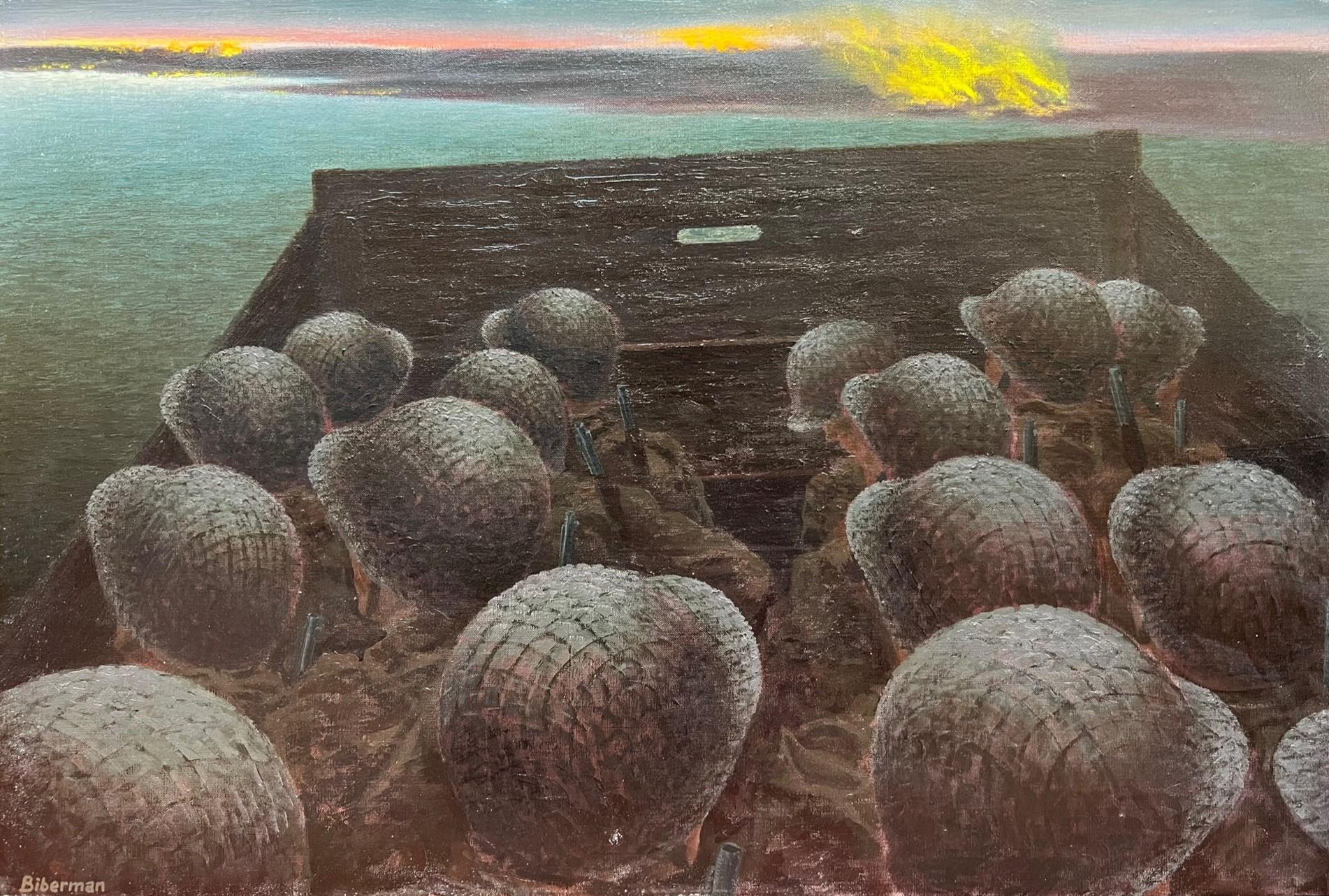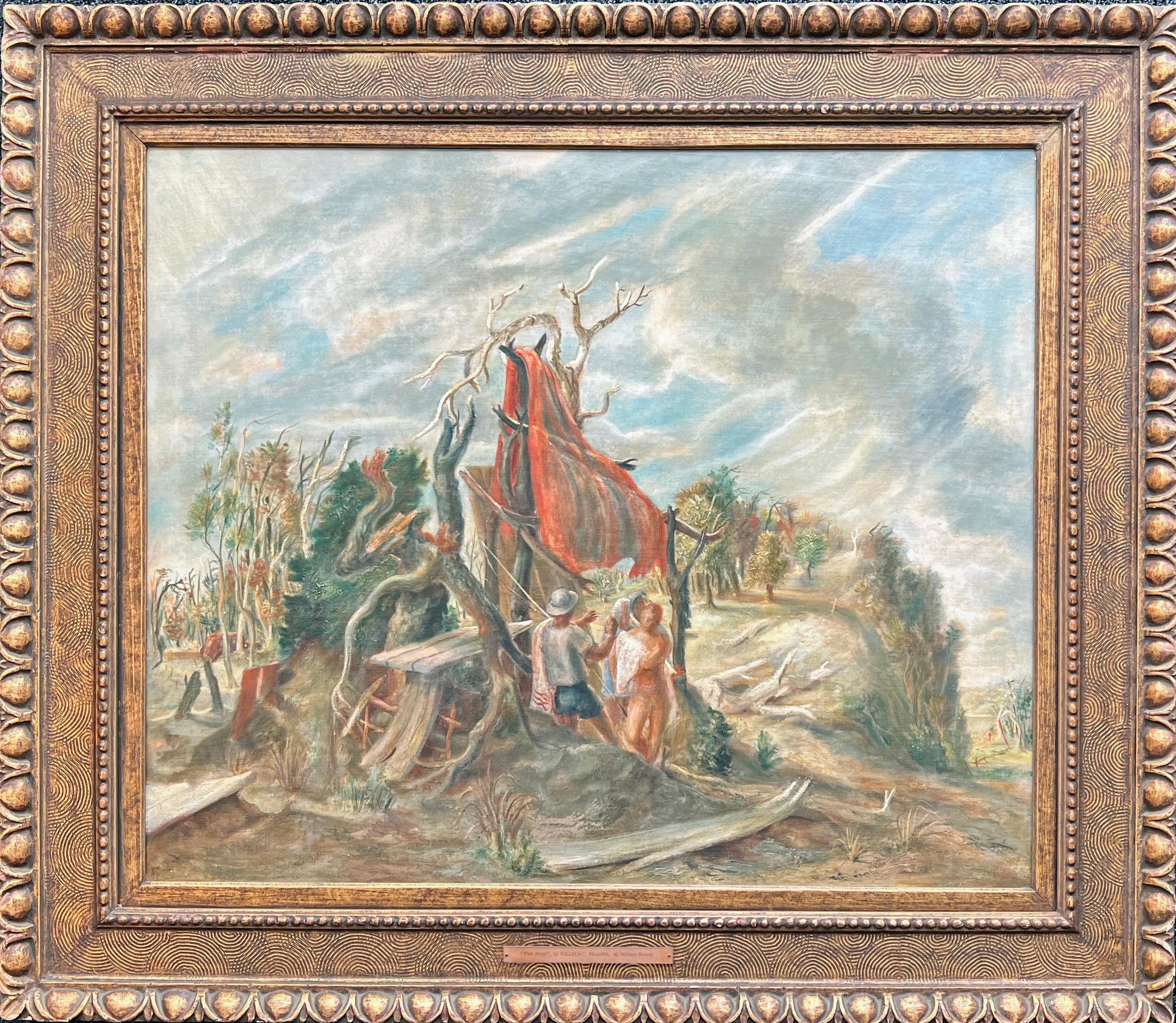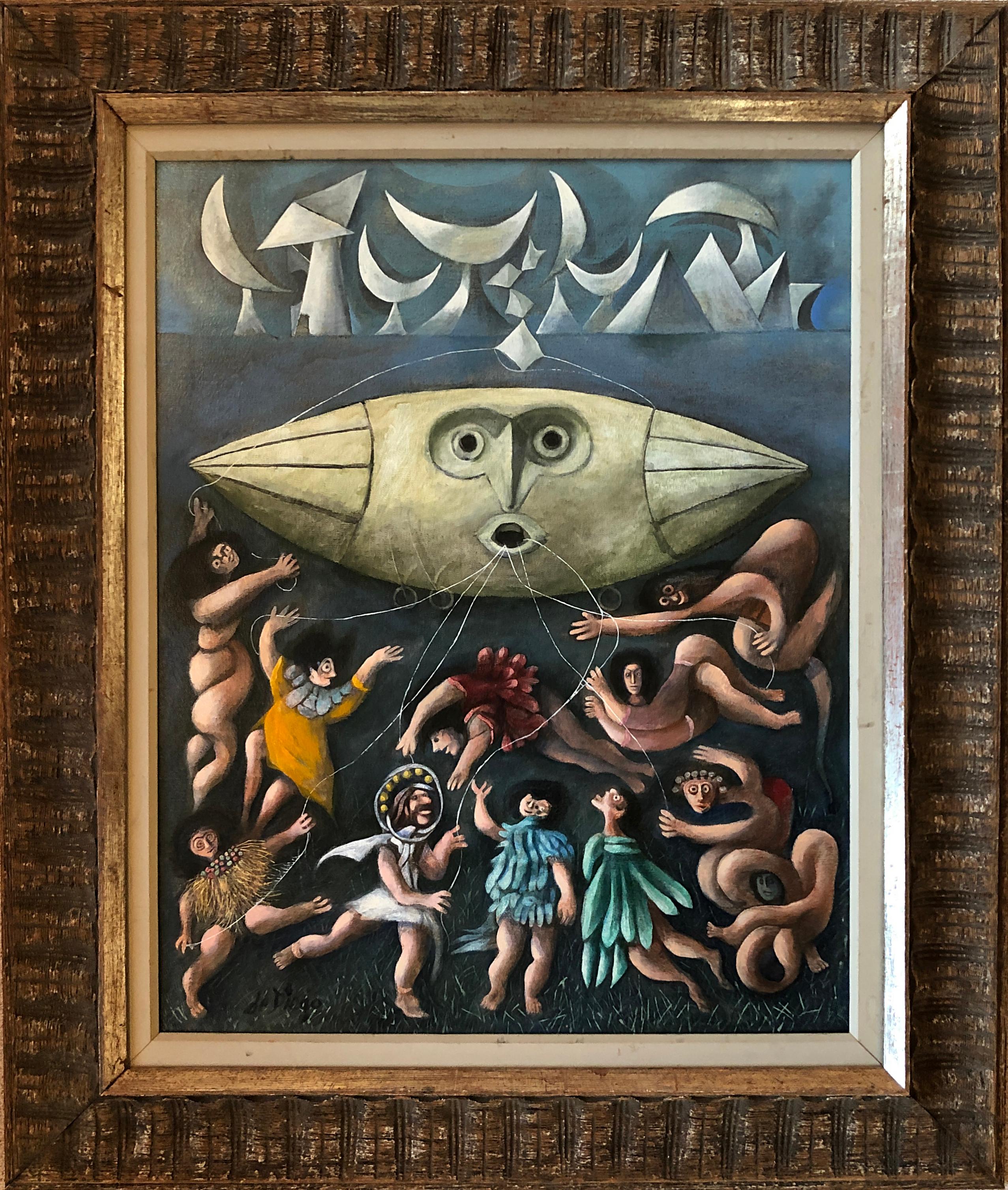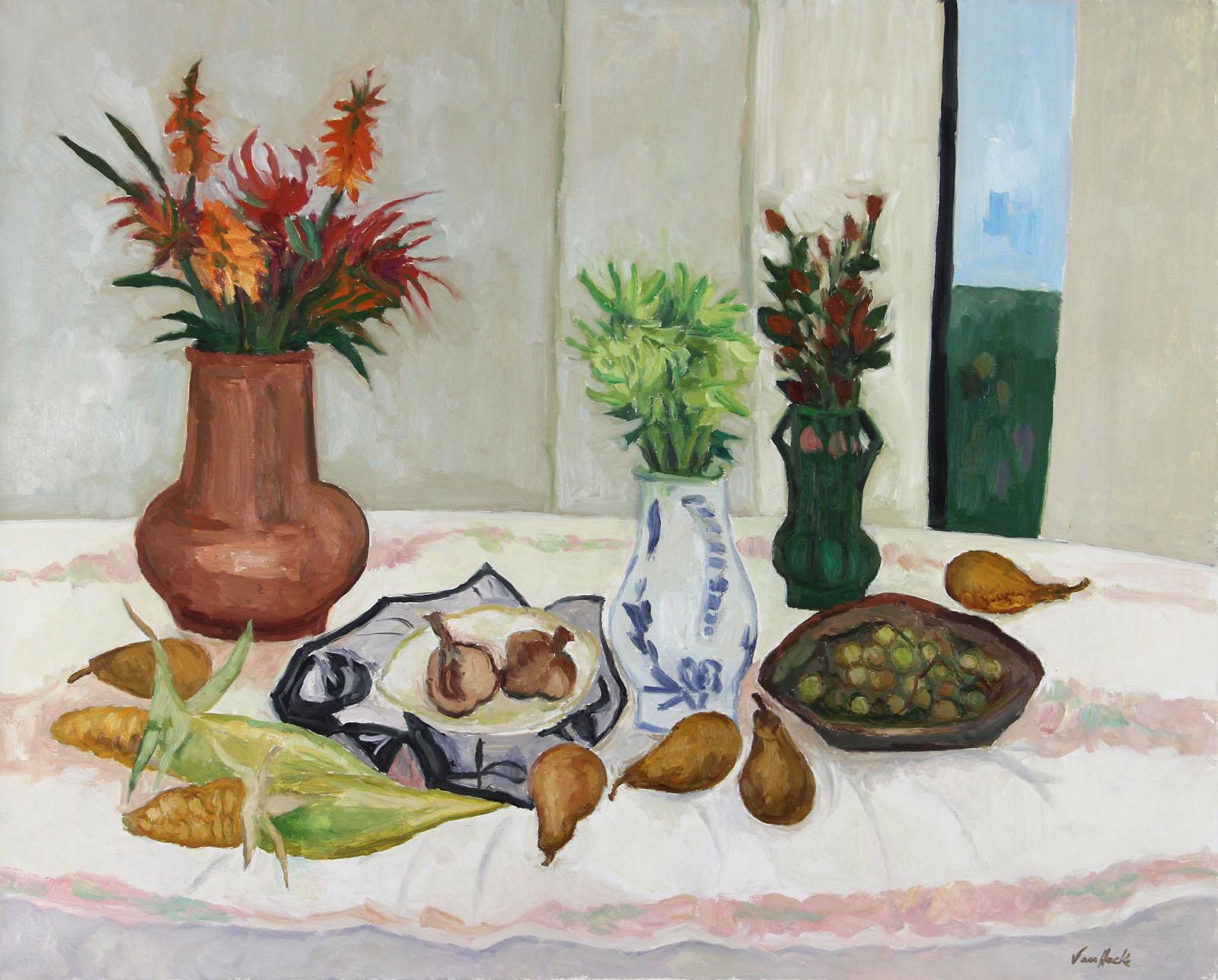Items Similar to Corrida Espagnole by JEAN DUFY - Bullfighting scene, oil on canvas, modern art
Want more images or videos?
Request additional images or videos from the seller
1 of 8
Jean DufyCorrida Espagnole by JEAN DUFY - Bullfighting scene, oil on canvas, modern art
About the Item
Corrida Espagnole by JEAN DUFY (1888-1964)
Oil on canvas
33.2 x 55.3 cm (13 ¹/₈ x 21 ³/₄ inches)
Signed lower right, Jean Dufy
This work is accompanied by a certificate of authenticity signed by Jacques Bailly and dated 12th September 2012.
This work will be included in the forthcoming Catalogue Raisonné vol.3 currently being prepared by Jacques Bailly.
Provenance
FAR Gallery, New York, New York
Newman Galleries, Philadelphia, Pennsylvania
Private Collection, Philadelphia, acquired from the above in 1954
Private European collection
Artist biography
Born into a large family in the busy port-city of La Havre in northern France, Jean Dufy was the younger brother of the Fauvist painter Raoul Dufy. In order to please his accountant father, Jean was trained in business and languages and at the age of sixteen began work as an administrative clerk and secretary in what he would later describe as a ‘stifling’ atmosphere. Nevertheless, thanks to his employer (The General Transatlantic Company) as part of his duties Jean travelled to New York City on up to fifteen occasions. Unlike many of his artistic contemporaries, Jean, therefore, had the extraordinarily opportunity of experiencing first-hand the cradle of modernity. In the spring of 1906, when Jean was eighteen, he visited an exhibition at La Havre townhall, partly organised by his brother Raoul and featuring, amongst others, the striking work of artists Henri Matisse and Pablo Picasso. Jean’s experience of their work and the feelings they provoked in him were revelatory and resolved him to become an artist.
Called-up for national service in 1909, Jean served in a cavalry officer, before moving in 1912 to Montmartre in Paris. Whilst earning money as a designer for a fabric manufacturer, Jean began painting and experimenting with colour. In pursuit of what Raoul called his ‘new kind of beauty’, Jean’s pictures were recognised by French art dealer Berthe Weill who, in January 1914, gave him his first solo exhibition at her gallery in Pigalle. The First World War broke out only seven months later and Jean was mobilized, spending what he called ’52 months of service’ in various front-line roles until 1919. Returning to Paris, Jean took on another studio near Montmartre cemetery and immediately resumed painting. In December 1922, he married divorcee Ismérie ‘Lily’ Coutut and - although they would have no children - they remained happily married until their deaths over forty years later.
During the 1920s Jean’s exuberant paintings were exhibited extensively, whilst he continued to design fabrics as well as award-winning tableware, vases and porcelain. In the spring of 1930, Jean enjoyed the first of many exhibitions in New York City at the Balzac Galleries in Midtown. For the 1937 International Exhibition in Paris, Jean’s brother Raoul Dufy was commissioned to create a vast mural on the theme of ‘electricity’. Although Jean was quickly enlisted by Raoul as his collaborator, Raoul’s insistence on receiving all the praise began their gradual estrangement which lasted until Raoul’s death in 1953.
After the Second World War, Jean continued to exhibit paintings in Paris as well as throughout the United States – New York City, Philadelphia, Boston, Portland, Chicago and Arizona – and even at Montreal in Canada. The New York Times perceptively described his colourful ‘modernistic’ Paris scenes as looking like ‘notes of music’. Chasing inspiration, during the 1950s Jean took the opportunity to travel widely across Europe and North Africa. At the same time, a young American student in Paris called Jacqueline Bouvier bought a small and characteristic gouache of a beach scene by Jean, which would hang – when she became First Lady Jackie Kennedy – at the heart of the White House. Jean’s work soon featured in public collections across Europe and the United States. Yet, overwhelmed by the death of his wife at their home in rural France in March 1964, Jean’s ‘life lost its meaning’ and – only two months later - he died that May.
- Creator:Jean Dufy (1888 - 1964, French)
- Dimensions:Height: 13.08 in (33.2 cm)Width: 21.78 in (55.3 cm)
- Medium:
- Movement & Style:
- Period:
- Condition:
- Gallery Location:London, GB
- Reference Number:1stDibs: LU261213462912
About the Seller
5.0
Recognized Seller
These prestigious sellers are industry leaders and represent the highest echelon for item quality and design.
Platinum Seller
These expertly vetted sellers are 1stDibs' most experienced sellers and are rated highest by our customers.
Established in 1964
1stDibs seller since 2015
95 sales on 1stDibs
Typical response time: 4 hours
Associations
Society Of London Art Dealers
- ShippingRetrieving quote...Ships From: London, United Kingdom
- Return PolicyA return for this item may be initiated within 7 days of delivery.
More From This SellerView All
- Animal painting by Orovida Camille Pissarro titled 'Exercising Ponies'By Orovida PissarroLocated in London, GB*UK BUYERS WILL PAY AN ADDITIONAL 20% VAT ON TOP OF THE ABOVE PRICE Exercising Ponies by Orovida Camille Pissarro (1893-1968) Oil on board 101.5 x 76 cm (40 x 30 inches) Signed and dated lower right Orovida 1954 Provenance Estate of Orovida Pissarro With John Bensusan-Butt, cousin of the artist Sotheby's London, 12th October 1988 G Hassell, 25th November 1988 With John Noott, 10th June 1992 Literature K L Erickson, Orovida Pissarro: Painter and Print-Maker with A Catalogue Raisonné of Paintings, (doctoral thesis), Oxford, 1992, Appendices, no. 161 (illustrated) Exhibitions London, Bowmore Gallery, Women in Art 1850-1989, 2nd-11th November 1989 Fort Lauderdale, Museum of Art, Camille Pissarro and his Descendants, January-April 2000, no.123 This work was included in the above important museum exhibition and a catalogue of the Fort Lauderdale museum show will be included with this painting. Biography Orovida Camille Pissarro, the only child of Lucien and Esther Pissarro, was the first woman in the Pissarro family to become a professional artist and the first Pissarro of her generation to take up painting. Born in Epping, England, in 1893, she lived and worked predominantly in London, where she was a prominent member of several British arts clubs and societies. She first learned to paint in the Impressionist style from her father and, after a brief period of formal study with Walter Sickert in 1913, she renounced formal art schooling. Throughout her career, Orovida always remained outside mainstream British art movements. Much to Lucien's disappointment, she soon turned away from naturalistic painting and developed an unusual style that combined elements of Japanese, Chinese, Persian and Indian art. Her rejection of Impressionism, which, for the Pissarro family, was a way of life, and her simultaneous decision to drop her famous last name and use simply Orovida as a nom de peintre, reflected a desire for independence and distance from the family legacy, of which she nevertheless remained proud. Orovida's most distinctive works are her paintings from the 1920s...Category
1950s Modern Animal Paintings
MaterialsOil, Canvas
- The Fortune Teller by Orovida Pissarro - Oil paintingBy Orovida PissarroLocated in London, GB*UK BUYERS WILL PAY AN ADDITIONAL 20% VAT ON TOP OF THE ABOVE PRICE The Fortune Teller by Orovida Pissarro (1893-1968) Oil on canvas 60 x 73 cm (23 ⁵/₈ x 28 ³/₄ inches) Signed and d...Category
1950s Modern Figurative Paintings
MaterialsCanvas, Oil
- Tiger Surprises Black Buck by Orovida Pissarro - Animal paintingBy Orovida PissarroLocated in London, GB*UK BUYERS WILL PAY AN ADDITIONAL 20% VAT ON TOP OF THE ABOVE PRICE Tiger Surprises Black Buck by Orovida Pissarro (1893-1968) Oil on canvas 127 x 101.5 cm (50 x 40 inches) Signed and dated lower left Orovida 1960 Provenance The Leicester Galleries, London, circa 1965 Literature K L Erickson, Orovida Pissarro: Painter and Print-Maker with A Catalogue Raisonné of Paintings, (doctoral thesis), Oxford, 1992, Appendices, no. 195 (illustrated) Exhibition London, Royal Society of British Artists, 3rd-25th November 1960, no. 82 (possibly; titled Tiger Entangled) London, Royal Academy, 1961, no. 534 Colchester, The Minories, 3rd- 24th March 1962 London, The Leicester Galleries, 1965, no. 37 Artist biography Orovida Camille Pissarro, Lucien and Esther Pissarro’s only child, was the first woman in the Pissarro family as well as the first of her generation to become an artist. Born in Epping, England in 1893, she lived and worked predominantly in London where she became a prominent member of several British arts clubs and societies. She first learned to paint in the Impressionist style of her father, but after a brief period of formal study with Walter Sickert in 1913 she renounced formal art schooling. Throughout her career, Orovida always remained outside of any mainstream British art movements. Much to Lucien's disappointment she soon turned away from naturalistic painting and developed her own unusual style combining elements of Japanese, Chinese, Persian and Indian art. Her rejection of Impressionism, which for the Pissarro family had become a way of life, together with the simultaneous decision to drop her famous last name and simply use Orovida as a ‘nom de peintre’, reflected a deep desire for independence and distance from the weight of the family legacy. Orovida's most distinctive and notable works were produced from the period of 1919 to 1939 using her own homemade egg tempera applied in thin, delicate washes to silk, linen or paper and sometimes embellished with brocade borders. These elegant and richly decorative works generally depict Eastern, Asian and African subjects, such as Mongolian horse...Category
1960s Modern Animal Paintings
MaterialsCanvas, Oil
- Migrating horses by Orovida Pissarro - Animal paintingBy Orovida PissarroLocated in London, GB*UK BUYERS WILL PAY AN ADDITIONAL 20% VAT ON TOP OF THE ABOVE PRICE Migrating horses by Orovida Pissarro (1893-1968) Oil on canvas 71.1 x 81.4 cm (28 x 32 inches) Signed and dated l...Category
1950s Modern Figurative Paintings
MaterialsCanvas, Oil
- Caterwaul by Orovida Pissarro - Animal paintingBy Orovida PissarroLocated in London, GBCaterwaul by Orovida Pissarro (1893-1968) Oil on canvas 51 x 61 cm (20 ¹/₈ x 24 inches) Provenance Estate of the artist With John Bensusan-Butt, cousin of the artist G Hassell, 25th...Category
1950s Modern Animal Paintings
MaterialsCanvas, Oil
- The Cattery by Orovida Pissarro - Animal paintingBy Orovida PissarroLocated in London, GBThe Cattery by Orovida Pissarro (1893-1968) Oil and pencil on canvas 61 x 51 cm (24 x 20 ⅛ inches) Signed and dated upper right Orovida 1964 Provenance Estate of the artist G Hassel...Category
1960s Modern Animal Paintings
MaterialsCanvas, Oil, Pencil
You May Also Like
- 20th century oil painting entitled The Unknown CornerLocated in London, GBCollections: Robert Isaacson; James Draper, New York, 2014. Exhibited: Cambridge, The Fitzwilliam Museum, Beggarstaffs: William Nicholson and James Pr...Category
Early 20th Century Modern Figurative Paintings
MaterialsCanvas, Oil
- Six O'ClockLocated in Los Angeles, CASix O-Clock, c. 1942, oil on canvas, 30 x 20 inches, signed and titled several times verso of frame and stretcher (perhaps by another hand), marked “Rehn” several times on frame (for the Frank K. M. Rehn Galleries in New York City, who represented Craig at the time); Exhibited: 1) 18th Biennial Exhibition of Contemporary American Oil Paintings from March 21 to May 2, 1943 at The Corcoran Gallery of Art in Washington, D.C. #87, original price $450 (per catalog) (exhibition label verso), 2) Craig’s one-man show at the Frank K. M. Rehn Galleries, New York City, from October 26 to November 14, 1942, #10 (original price listed as $350); and 3) Exhibition of thirty paintings sponsored by the Harrisburg Art Association at the State Museum of Pennsylvania in Harrisburg in March, 1944 (concerning this exhibit, Penelope Redd of The Evening News (Harrisburg, Pennsylvania) wrote: “Other paintings that have overtones of superrealism inherent in the subjects include Tom Craig’s California nocturne, ‘Six O’Clock,’ two figures moving through the twilight . . . .” March 6, 1944, p. 13); another label verso from The Museum of Art of Toledo (Ohio): original frame: Provenance includes George Stern Gallery, Los Angeles, CA About the Painting Long before Chris Burden’s iconic installation outside of the Los Angeles County Museum of Art, Urban Light, another artist, Tom Craig, made Southern California streetlights the subject of one of his early 1940s paintings. Consisting of dozens of recycled streetlights from the 1920s and 1930s forming a classical colonnade at the museum’s entrance, Burden’s Urban Light has become a symbol of Los Angeles. For Burden, the streetlights represent what constitutes an advanced society, something “safe after dark and beautiful to behold.” It seems that Craig is playing on the same theme in Six O-Clock. Although we see two hunched figures trudging along the sidewalk at the end of a long day, the real stars of this painting are the streetlights which brighten the twilight and silhouette another iconic symbol of Los Angeles, the palm trees in the distance. Mountains in the background and the distant view of a suburban neighborhood join the streetlights and palm trees as classic subject matter for a California Scene painting, but Craig gives us a twist by depicting the scene not as a sun-drenched natural expanse. Rather, Craig uses thin layers of oil paint, mimicking the watercolor technique for which he is most famous, to show us the twinkling beauty of manmade light and the safety it affords. Although Southern California is a land of natural wonders, the interventions of humanity are already everywhere in Los Angeles and as one critic noted, the resulting painting has an air of “superrealism.” About the Artist Thomas Theodore Craig was a well-known fixture in the Southern California art scene. He was born in Upland California. Craig graduated with a degree in botany from Pomona College and studied painting at Pamona and the Chouinard Art School with Stanton MacDonald-Wright and Barse Miller among others. He became close friends with fellow artist Milford Zornes...Category
1940s American Modern Landscape Paintings
MaterialsCanvas, Oil
- The Landing/Dawn LandingLocated in Los Angeles, CAThis painting is part of our exhibition America Coast to Coast: Artists of the 1940s. The Landing/Dawn Landing, 1944, oil on canvas, signed lower left, 20 x 30, titled verso; exhib...Category
1940s American Modern Paintings
MaterialsCanvas, Oil
- Fish Story oil painting by Williams Charles PalmerLocated in Hudson, NYThis painting is illustrated in the Catalogue of the 1945 Encyclopedia Britannica Collection of Contemporary American Painting, p.84. Written and edited by Grace Pagano. "Painting ...Category
Mid-20th Century American Modern Figurative Paintings
MaterialsOil, Canvas
- Lords of the Sky oil painting by Julio De DiegoBy Julio de DiegoLocated in Hudson, NYLords of the Sky (c.1950) Oil on canvas, 30" x 24" 40" x 34" x 2" framed Provenance: The Artist, his daughter About this artist: Julio De Diego crafted a formidable persona within ...Category
Mid-20th Century Modern Figurative Paintings
MaterialsCanvas, Oil
- Fruits, maïs et raisinsLocated in LE HAVRE, FRArthur VAN HECKE (1924-2003) Fruits, maïs et raisins Oil on canvas Size: 81 x 100cm Signed lower right Painting in perfect condition, sold unframed. Origin: - Artist's studio - Mar...Category
1990s Modern Figurative Paintings
MaterialsCanvas, Oil





